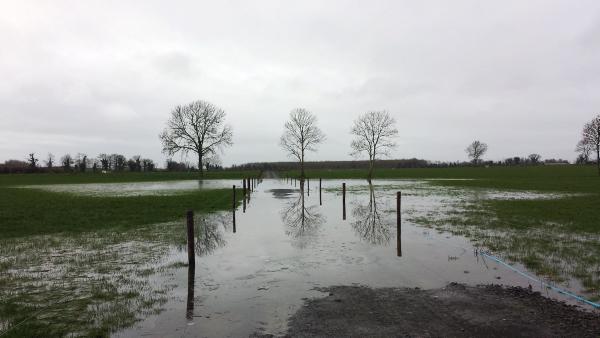February is a very busy time of the year on a compact spring calving farm. When you throw hurricanes, standoff pads, torrential rain, no electricity and compact calving into the mix, you can get a system very near breaking point.
We all know a good routine – eating well, planning and as much sleep as possible – helps as you go through a busy spring.
However, even with the best plans in the world, there are, and will be, pressure points. In my opinion, the last two weeks in Kilkenny have been as bad as it gets in terms of pressure since the start of farm development in late 2009.
Over the last five years, we have had snow, freezing temperatures, and drought, but all at times of the year that didn’t impact very hard on man or beast.
Over the last two weeks, the cold, torrential rain has made working and managing 300 compact calving spring cows very difficult.
In Kilkenny, 180 cows calved in the first three weeks of February – as compact as we have had since the farm was converted. Conditions have been very difficult for grazing and, as you know, in Kilkenny, cows are turned out to grass after calving as there are little or no facilities for housing milking cows.
Now, remember the Kilkenny farm is a very dry farm and good infrastructure and planned grazing strategies help minimise damage but, call a spade a spade, no matter where you turned a cow last week, if she had to get a few hours at grass, it was going to be difficult.
Never before have the volumes of rain been so significant. We’ve had more rain in Kilkenny in the first two months of a very busy period than we had for six months in 2013.
Last weekend, there were still very visible floods around the farm, despite little or no rain Friday or Saturday (see more in video).
The damage to paddocks has been minimised but it comes at a cost to man and beast. Cows will lose condition score and the worker can get frustrated, tired, pressurised and stressed.
This is a real, commercial test of the spring calving system and it’s not a trial that can be turned off and on, depending on what suits.
Farm labour
Farm manager Tom Lyng is supported this year by Eddie Kennedy from north Tipperary. UCD student Michael Whitely from near the farm in Kilkenny is helping out on the farm until April.
Eoin Finneran from Roscommon has also joined the farm team for a few weeks to help out with calf rearing and other issues around the farm.
Tom and Eddie are fulltime staff and so both take the lead in terms of responsibility and decision-making. Tom has been working on the farm for three years and, at Christmas, took over from Michael Long as farm manager.
Eddie has just joined the farm team so, again, both lads have to get to know how to work together, how to divide up the workload, set up the system and work with the students to make the farm work.
Farm staff must get on with each other because you work side-by-side.
Tom and Eddie are obviously key to the success of this set-up and, between them, they take the lead in calving, milking, breeding and grassland management.
On this farm, unlike most others, all machinery work is contracted out and workers spend no time working or running machinery.
Tom is also responsible for registering, BVD testing and selling bull calves plus any other stock. All of this important office-type work takes up time at a busy time of the year when, every time you look out the window, there is a cow with a tail up in the air or a blister hitting the ground.
Pressure points
The last number of somatic cell count (SCC) readings have come back higher than Tom would like. The most recent result was 380,000 SCC for a milk collection early this week – SCC is measured at each collection.
No cow is let into the bulk tank unless she passes the CMT paddle test but, obviously, some cows have sub-clinical mastitis (no clots) which is pushing SCC up.
Tom has found a good bit of mastitis in heifers calving down and the matter is under investigation. He has taken individual quarter samples from calved heifers to identify which quarters are infected and the cause of mastitis.
The results have just come back (yesterday) and there is a good bit of Staph mastitis, which is contagious, so these heifers will be milked last and put in the treatment herd.
There are some warts, etc., on freshly calved heifers but less than 10% are troubled in this way. Latest milk composition results are fat 5.73% and protein 3.69%.
Heifers come home from the contract rearing unit to the standoff pad two weeks before calving.
Some suggest we should teat-seal the heifers before they spring up.
There was also a high total bacterial count (TBC) last week also. The plate cooler was dismantled and washed down, the bulk tank was checked, because previously this had been an issue, and hot water temperatures were checked.
No definitive cause was nailed down but the TBC results are back down around 10 now.
Without a doubt, last week the weather added extra pressure. Power to the farm was cut from Wednesday afternoon at 3pm and so the cows were only milked once on Wednesday.
Power has only been working intermittently since as ESB staff fix the ongoing problems. A generator was hired for €650 for the week and is switched on as required.
Calving outdoors in cold and wet weather is very difficult. Once a calf is born, it needs care very quickly.
When you have 20 calving in the one day, with maybe half of them coming under the cover of darkness, you begin to understand the pressure.
Despite the heavy rain, grazing is continuing and freshly calved cows are allocated grass after each milking. They are also supplemented with wholecrop wheat and meal.
Grazing on the very wet and cold days is obviously not ideal but that’s the system and the cow is bred to graze.
Milk yield is not the primary focus – getting the best high quality feed into cows is the focus.
No bag nitrogen has been spread yet and this will be more of a concern as the spring moves along because over 30% of the farm will have been grazed by end of February.
There are paddocks with yellow grass now that visibly look like they need nitrogen. Ideally, they would be grazed off and nitrogen spread but ground conditions are simply too wet for spreading.
Saving graces
Thankfully, there is still a good pit of silage on the farm and, now that 180 cows are calved, more and more of their diet will be grazed grass and meal.
There may be a few weeks in April where forage may come back in the picture for these milking cows, but at least we have it in the yard.
Roadways are in top class condition and the surface is smooth so there is no problem walking cows long distances and they seem to be coping well so far.
Again, thankfully, there is a good cover of grass on the farm and some paddocks have covers over 1,500kg which can be grazed now that there are a good number of cows calved.
Up to now, the cows have been going into lower covers, less than 1,000kg, as the cows learn how to graze again. As the wet weather continues, because the drier paddocks are grazed first, decisions will become more difficult.
The standoff pad has coped relatively well with the heavy rain since the woodchip was replaced in the middle of January.
There are early signs that the price of woodchip is coming down but, based on the price of a load of woodchip purchased at €700 to €1,200 per load, it has become too costly to operate and other options will be assessed.
Last weekend, the pressure has come off the standoff pad and now it is possible to fence back the cows from the feed face during the day and let them eat at night.
This makes them think about eating at nighttime rather than calving during the night. So far, it seems to be working.






 This is a subscriber-only article
This is a subscriber-only article









SHARING OPTIONS: